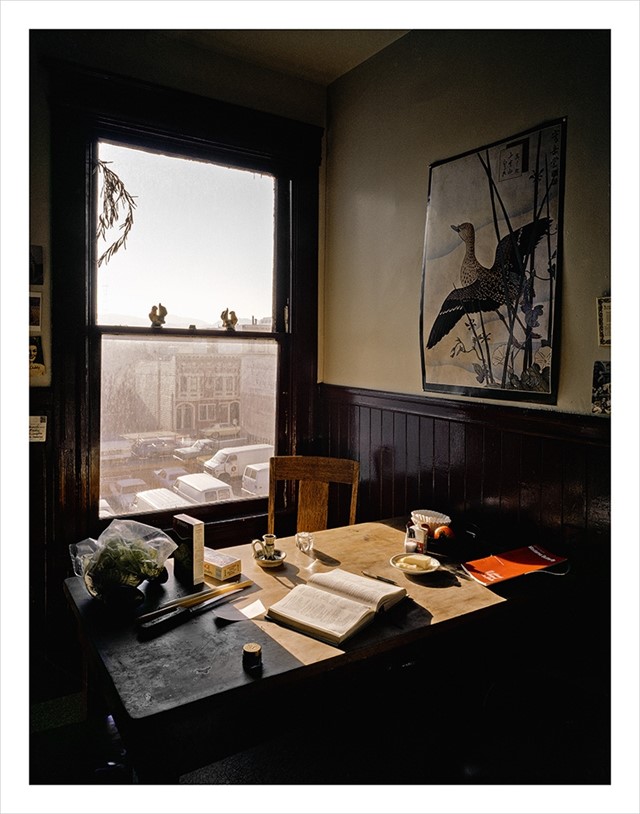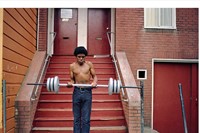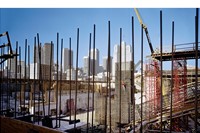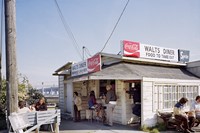Photographer Janet Delaney discusses her beautiful book depicting life and politics in 80s San Francisco
Ever since Scott McKenzie implored visitors to San Francisco to wear flowers in their hair, the city has been a site of pilgrimage for people seeking acceptance, liberality, inspiration and joy. Young photographer Janet Delaney arrived from Los Angeles in the early seventies, and settled in a cheap area known as South of Market. She quickly became aware that her arrival represented the latest in a relentless process of gentrification that was pushing up rents, and pushing out the existing community of working class factory workers and small business owners. Determined to record a portrait of a society that was being eradicated by economic change, she set to photographing and interviewing her neighbours in their homes and work places, adding her images to the voices protesting at their treatment.
The result is an insightful work of historical record, depicting the city at a fascinating juncture in its history – depicting the arrival into San Francisco of the gay community, prior to the AIDS epidemic – while being a timely reminder of the cyclical nature of progress, as a new wave of aspirants arrive seeking success in the booming tech industry. Delaney says, “I did not intend these large-format color images to be a romantic representation of the past. Rather, I wanted them to be a testimony to the people who were moved out, the neighborhoods that were destroyed, and the jobs that were lost.” And this they do, yet while the pictures retain a steely purpose, they also glow with a luminous beauty, imbued with an artist’s love for her city.
As the book is released, here we talk to Delaney about her inspiration and continuing love affair with San Francisco.
What brought you to San Francisco?
I moved here from Los Angeles in 1972, at a time when everybody was moving to San Francisco. It was a Mecca in the late sixties and early seventies for anybody who had an awareness of the new liberal paradigm, and there was a big calling to be part of free love and the experimental lifestyle. After a few years of travelling further abroad, I landed in this rather derelict neighborhood, which unexpectedly became home.

What was at the heart of the mission for this project?
Well for me personally, I was part of the transitional community, but when I got there I became more and more aware of the impact that gentrification was having on the neighbourhood. I myself was part of it as a young white woman moving in. So the point was that change happens in cities but how is it mediated and at whose cost? Who plays and who pays? My neighbourhood was a very tight knit African-American community and then a Filipino community came in as they were establishing themselves in the neighbourhood and before that it had been an Irish part of town. It had always been the landing place for new immigrants because it was the working class neighborhood with lots of factories, lots of jobs and housing right next to the jobs. And I was watching the transition as the rents increased and it became more desirable to live there, because of urban renewal and the Moscone Convention Centre coming in. This change was hard to name photographically because it hadn’t happened yet so I decided to photograph the people represented who had been moved out.
These pictures are so intimate and relatable and yet clearly their point was political. How do you feel about the two things work together?
It was politically motivated but I wanted to make that story accessible and seductive and I wanted people to understand what was happening. So I decided to shoot in colour which was rather unusual at that time. I wanted to say, ‘look what’s here, we need to really pay attention’, so shot using a view camera, a tripod, a very slow process and lots of communication between me and the subject. In fact the challenge was to make a 'not place' a place. The area wasn’t like Chinatown or the Mission District in San Francisco where there are a lot of identifying factors. South of Market at that point was very bland, so I had to identify the spirit of the place.
You’re very firm about it not being a romantic work, that it’s political – yet there is something so inherently beautiful about it. Do you ever worry that the romance might overtake it?
Oh yeah absolutely. I projected into the future that some day these images would be seen as a romantic representation of the past and I was working really diligently whilst I was doing the project to make them function in the moment. The idea was always about showing the work in unusual places and showing the work as an activist. Now that the book is coming out, I’m adamant to keep that same element alive.
You first came to San Francisco in the hope of finding something new and exciting which you found here. If you were that age now would you come to San Francisco, or is there another city or a part of the world where you get a similar feeling?
I was just in Berlin and Paris and I’ve been to Delhi and I’ve been to Beijing in the last year or two. It’s so personal, your sense of home and I think when you get some place and you feel it, then you know it. People love San Francisco passionately and it isn’t because it’s beautiful like Paris. I was saying last night after coming home two days ago that it’s kind of a hot mess. It’s irregular, it's chaotic, there’s a lot of people on the streets and there are characters, somebody on a weird contraption in a silver suit or people riding down the street... People start to realize themselves here and I don’t know if there’s a more liberal city. Of course it is tough with the rent but you can move to Oakland! I would say that each individual should try it out. I’m a real advocate for San Francisco because I fell in love here. When you fall In love with the place, I think that’s just something that happens at a certain moment and people leave but not often! You can make things happen here, it’s full of innovation.
South of Market by Janet Delaney is out now, published by Mack.



